Some birds look more like nightmares than nature’s creations. The marabou stork, with its hunched vulture-like stance and bald, wrinkled head, is one of the ugliest scavengers in the animal kingdom, while the shoebill’s eerie, unblinking stare makes it downright scary. The wide-eyed potoo looks permanently creepy, and the southern screamer is both goofy and unsettling at the same time. But as strange, ugly, or terrifying as these birds may seem, every bizarre feature has a purpose, shaped by evolution for survival.
For our long-time readers, this article is a step away from our usual conservation and scientific deep dives. We noticed that most lists of ugly birds online simply showcase creepy-looking species without explaining why they look this way, so we decided to change that. Let’s take a closer look at these misunderstood beauties and uncover the science behind their scary, strange, and ugliest features.
Marabou stork (Leptoptilos crumenifer)
- Why ugly? Bald, wrinkled head, scruffy feathers, and an oversized beak make it look like a vulture in disguise.
- Where found? Sub-Saharan Africa, wetlands, garbage dumps, and urban areas.
- What it eats? Scavenger – feeds on carrion, garbage, small animals, and even human food waste.
- Status: Least Concern, but habitat loss and pollution affect populations.

Towering at up to 1.5 meters (5 feet) tall, with a wingspan of over 3.5 meters (11 feet), the marabou stork is an unmistakable presence in African wetlands. Its hunched posture, patchy, dirty-looking plumage, and bald, wrinkled head give it a vulture-like, almost sinister appearance. Adding to its eerie look is a large, fleshy throat pouch, which expands and contracts, making the bird appear even more unusual. While it might not win any beauty contests, this scavenger plays a vital ecological role, cleaning up decaying matter that other animals leave behind.
Why does it look this way?
So why does the marabou stork look so strange, ugly, and almost creepy? Its bald head serves the same purpose as that of vultures – keeping its feathers clean while feeding on rotting carcasses. The throat pouch, while unsettling, helps with thermoregulation and communication, inflating when the bird wants to appear more dominant. Even its ragged, loose feathers aid in heat control in Africa’s hot climate. In the end, the marabou stork isn’t just ugly, it’s a highly adapted survivor, thriving in an often-overlooked but essential ecological role.
Shoebill (Balaeniceps rex)
- Why ugly? Oversized beak, piercing stare, and slow, mechanical movements give it a prehistoric look.
- Where found? Swamps of central Africa (South Sudan, Uganda, Zambia).
- What it eats? Lungfish, catfish, and large aquatic prey.
- Status: Vulnerable, threatened by habitat loss and human disturbance.
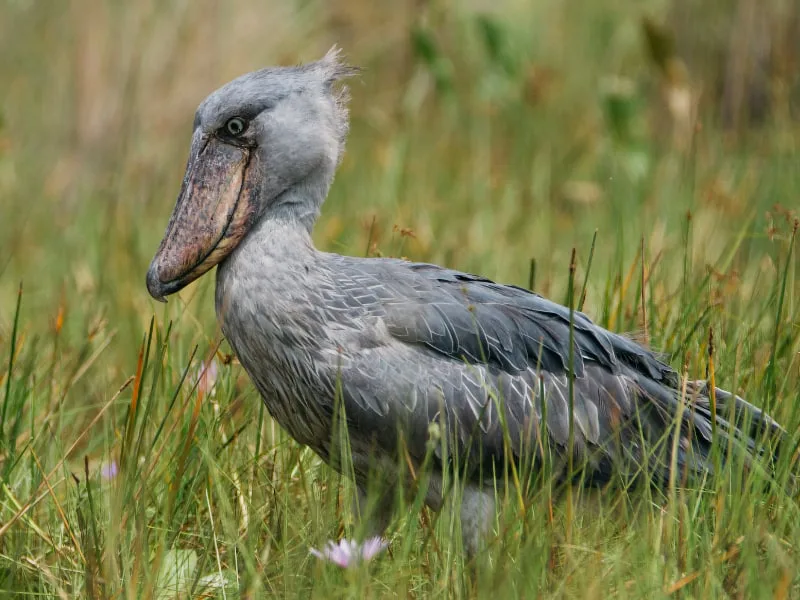
Standing over four feet tall, the shoebill is an imposing figure in the wetlands of central Africa. Its enormous, shoe-shaped beak, up to 24 cm (9.5 inches) long, gives it a strange, almost cartoonish look, but its intense, unblinking stare makes it far more intimidating than goofy. Unlike most birds, the shoebill moves slowly and deliberately, often standing completely still before striking with shocking speed. Its mechanical movements and eerie presence make it one of the most unusual and unsettling birds in the world.
Why does it look this way?
The shoebill’s massive beak is a precision tool for catching large, slippery prey like lungfish and catfish. Its broad, hooked shape helps it grab, crush, and decapitate fish before swallowing them whole. The bird’s slow, patient movements are an evolutionary advantage, allowing it to ambush prey in shallow swamps. Even its creepy, piercing gaze serves a function, helping it detect movement with extreme precision. Though it may look like a relic from the dinosaur age, the shoebill is a masterful predator, perfectly adapted to its wetland habitat.
Turkey vulture (Cathartes aura)
- Why ugly? Bald, wrinkled red head and hunched posture give it a sinister, almost eerie look.
- Where found? North and South America, from Canada to Argentina.
- What it eats? Carrion – feeds exclusively on dead animals.
- Status: Least Concern, but faces threats from poisoning and habitat loss.

Gliding effortlessly across the skies with its wings held in a shallow V-shape, the turkey vulture is often mistaken for a bird of prey. However, a closer look reveals its creepy, wrinkled red head, which contrasts sharply with its dark, broad wings. Perched, it looks hunched and almost menacing, giving it the eerie silhouette often associated with death. Unlike most vultures, it rarely makes noise, adding to its unsettling presence. While many people find its bald, fleshy face unsettling, the turkey vulture is one of the most important scavengers in the ecosystem.
Why does it look this way?
That bald, wrinkled head isn’t just for show, it’s a highly practical adaptation for a life spent feeding on carcasses. A feathered head would trap bacteria and decaying flesh, leading to infections. Instead, the vulture’s bare skin is easier to keep clean, especially when exposed to the sun’s UV rays, which help kill harmful microbes. Its powerful sense of smell (one of the best among birds) allows it to detect decaying meat from miles away. While its awkward gait and hunched appearance might make it look goofy on the ground, in the air, the turkey vulture is a graceful, energy-efficient flyer that plays a vital role in maintaining the health of ecosystems.
Andean condor (Vultur gryphus)
- Why ugly? Wrinkled, bald head, sagging neck wattle, and hunched posture give it an ancient, almost mythical look.
- Where found? High mountains and coastal cliffs of South America, from Venezuela to Patagonia.
- What it eats? Scavenger – feeds on large carcasses like deer, livestock, and marine animals.
- Status: Vulnerable, with habitat destruction and poisoning being major threats.

With a wingspan of up to 3.3 meters (10.8 feet), the Andean condor is one of the largest flying birds in the world, soaring high over South America’s rugged landscapes. While majestic in flight, up close, it has an unsettling, wrinkled face, a thick, fleshy neck wattle, and a hunched, vulture-like posture that makes it look more like a relic from another time. Males have a prominent fleshy comb on their heads, adding to their bizarre appearance. Often depicted in Andean mythology as a symbol of power and endurance, the condor is both feared and revered.
Why does it look this way?
Like other vultures, its bald head is an adaptation for hygiene, preventing bacteria from accumulating while feeding on carrion. The large wingspan and broad feathers allow it to glide for hours without flapping, conserving energy while scanning for food. Its strong hooked beak is perfect for tearing through tough hides, and the thick ruff of feathers around its neck helps keep it warm in cold mountain air. Despite its somewhat creepy, ancient look, the Andean condor is an ecological guardian, ensuring that carcasses don’t accumulate and spread disease.
King vulture (Sarcoramphus papa)
- Why ugly? Bald head covered in wrinkled, fleshy folds, with bright orange, red, and purple skin giving it an unnatural, almost clownish look.
- Where found? Tropical forests of Central and South America.
- What it eats? Scavenger – feeds on carrion, often taking over carcasses from smaller vultures.
- Status: Least Concern, but habitat loss threatens populations in some areas.

The king vulture is one of the most strikingly bizarre scavengers in the world. With its brightly-colored, bald head, oversized hooked beak, and fleshy orange wattle hanging over its face, it looks almost artificial, like a poorly designed Halloween mask. In flight, it is an elegant and powerful bird, but up close, its bulging eyes and multicolored skin folds make it look unsettling. Despite its strange appearance, the king vulture dominates feeding sites, often driving off smaller vultures with its size and strength.
Why does it look this way?
Like other vultures, the king vulture’s bald head is for hygiene, keeping it clean while feeding on rotting meat. Its vivid facial colors are likely used for communication and mate attraction, as these birds lack vocal cords and rely on body language. The large, hooked beak is one of the strongest among vultures, allowing it to tear open thick-skinned carcasses that other scavengers can’t access. Once it opens a carcass, smaller vultures follow to feed on the remains. Though its face might look goofy and unsettling, the king vulture is a highly specialized and efficient scavenger, playing a critical role in its ecosystem.
Hoatzin (Opisthocomus hoazin)
- Why ugly? Spiky crest, hunched posture, and an overall scruffy, prehistoric look give it an almost mythical appearance.
- Where found? Amazon rainforest, near rivers and swamps in South America.
- What it eats? Mostly leaves, with some flowers and fruit.
- Status: Least Concern, but habitat destruction threatens populations.
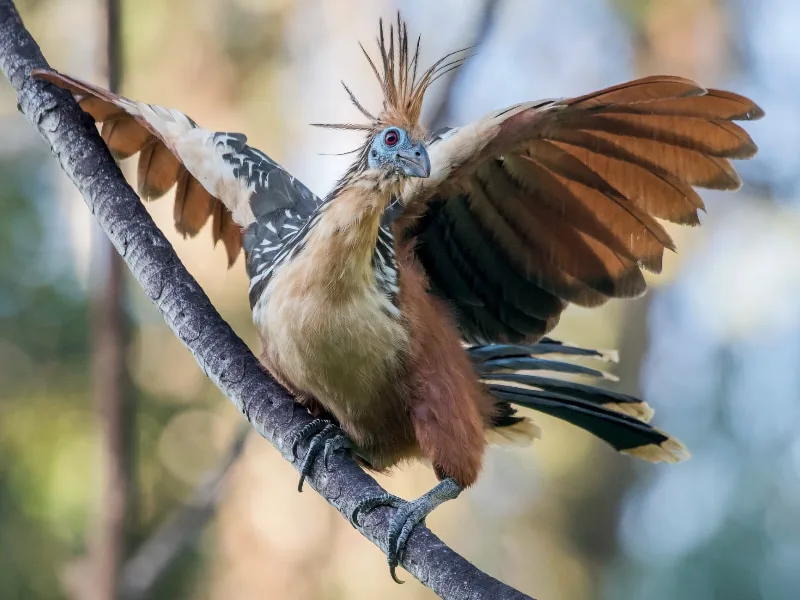
The hoatzin looks like a strange evolutionary leftover, with its spiky, mohawk-like crest, hunched posture, and awkward movements. Its small head, bright red eyes, and patchy blue skin give it an eerie, almost cartoonish look, while its slow, clumsy way of moving through trees only adds to its bizarre reputation. But perhaps the weirdest thing about the hoatzin is its smell, earning it the nickname “stink bird” because it produces a strong, manure-like odor due to its unusual digestive system.
Why does it look this way?
The hoatzin is one of the only birds that ferments its food like a cow, with a specialized stomach that breaks down tough leaves. This gut fermentation produces gases that give the bird its foul smell, likely acting as a deterrent to predators. Its large crop (a digestive pouch) makes its chest appear bloated, adding to its awkward, hunched shape. Young hoatzins are even stranger, they have clawed fingers on their wings, which they use to climb trees before they can fly, a trait rarely seen in modern birds. While its appearance and smell might make it one of the ugliest birds, the hoatzin is a unique survivor, with an evolutionary lineage stretching back millions of years.
Southern cassowary (Casuarius casuarius)
- Why ugly? Thick, helmet-like casque, wrinkled blue skin, and a dinosaur-like posture make it look prehistoric.
- Where found? Tropical rainforests of Australia, New Guinea, and nearby islands.
- What it eats? Fruits, fungi, small animals, and carrion.
- Status: Least Concern, but habitat loss and vehicle collisions are major threats.

The southern cassowary is among the largest flightless birds and one of the most intimidating, standing over 1.9 meters (6.2 feet) tall and weighing up to 85 kg (187.4 lbs). Its thick, scaly legs, long, sharp claws, and dark, shaggy feathers make it look like a relic from the dinosaur age, and for good reason – it is one of the closest living relatives of ancient theropods. The most striking and unsettling feature of the cassowary is the large, bony casque on its head, which adds to its eerie, otherworldly appearance. Despite its strange look, this bird is highly reclusive, but when threatened, it can deliver powerful kicks capable of injuring or even killing a human.
Why does it look this way?
The cassowary’s helmet-like casque has puzzled scientists for years, but it likely serves multiple purposes – it may act as a shock absorber when running through dense forests, help amplify low-frequency calls, or be a display for social dominance. Its wrinkled blue and red skin is an adaptation for thermoregulation, helping the bird release heat in humid environments. The long, dagger-like claws on its feet are not just for show, this bird is known for its powerful defensive kicks, making it one of the most dangerous birds in the world. While its strange and scary appearance might seem out of place in the modern world, the cassowary is a perfectly adapted rainforest giant, playing a key role in seed dispersal across its habitat.
Helmeted hornbill (Rhinoplax vigil)
- Why ugly? Oversized, helmet-like casque, wrinkled bare skin, and strange, laughing calls make it look and sound bizarre.
- Where found? Rainforests of Southeast Asia, including Indonesia, Malaysia, and Thailand.
- What it eats? Mainly figs, but also small animals and insects.
- Status: Critically Endangered, due to poaching for its casque and habitat destruction.

The helmeted hornbill is one of the strangest-looking and most unique hornbills, with a huge, solid casque on top of its head that makes up about 10% of its body weight. Unlike other hornbills, which have hollow casques, this species has a dense, ivory-like structure used for headbutting rivals in mid-air battles. Adding to its odd look is its wrinkled, bare red throat skin, which inflates during loud, eerie calls that sound like maniacal laughter. While it may seem goofy and unsettling, this bird is an important part of its ecosystem, helping to disperse seeds throughout the rainforest.
Listen to the helmeted hornbill call:
Why does it look this way?
The oversized casque is primarily used for combat and dominance – males engage in headbutting duels in flight, slamming their casques together to establish territory and mating rights. The casque also plays a role in vocal resonance, helping to amplify their loud, haunting calls. The bare red throat skin is likely used in communication and thermoregulation, changing color slightly depending on the bird’s state. Unfortunately, this strange, prehistoric-looking bird is on the brink of extinction due to the illegal trade in “hornbill ivory,” which has made it a prime target for poaching.
Lesser adjutant (Leptoptilos javanicus)
- Why ugly? Bald, wrinkled head, scruffy feathers, and long, bony legs give it a vulture-like, eerie look.
- Where found? Wetlands, mangroves, and rice fields across South and Southeast Asia.
- What it eats? Carrion, fish, amphibians, and small mammals.
- Status: Near Threatened, with habitat destruction and hunting reducing populations.
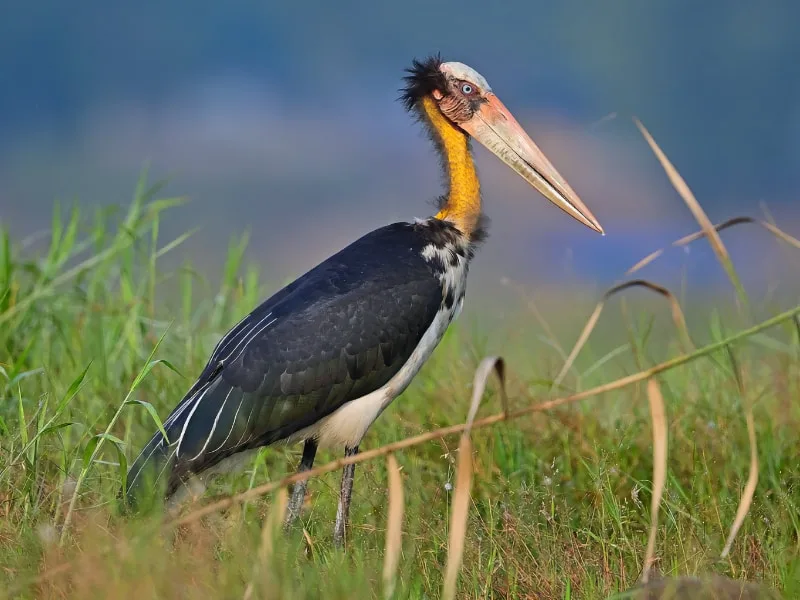
With its thin, featherless head, hunched posture, and ragged, disheveled feathers, the lesser adjutant stork looks like a creepy, oversized scarecrow wandering through marshes and fields. Its long, bony legs and slow, deliberate movements give it an almost zombie-like appearance, especially when it wades through shallow water in search of food. Compared to its relative, the greater adjutant, it has a slightly slimmer build but is just as unsettling to look at. Often seen lurking near garbage dumps or carcasses, the lesser adjutant is a highly adaptable scavenger, though its populations are in decline due to habitat destruction.
Why does it look this way?
The bald head and wrinkled skin are key adaptations for scavenging, helping the bird stay clean when feeding on carrion or in muddy waters. Its long legs and thin body allow it to wade through wetlands with minimal resistance, and its large, heavy bill is ideal for grabbing fish, frogs, and even small mammals. While its ragged, vulture-like appearance might seem unsettling, the lesser adjutant plays a critical role in cleaning up ecosystems, preventing the spread of disease by consuming decaying matter. Despite its ugly and ghostly look, it is an essential bird for wetland health.
Greater adjutant (Leptoptilos dubius)
- Why ugly? Bald, wrinkled head, massive throat pouch, and a hunched posture make it look unsettling and vulture-like.
- Where found? Wetlands, garbage dumps, and rice fields in India and Southeast Asia.
- What it eats? Carrion, fish, amphibians, and small mammals.
- Status: Near Threatened, with habitat loss and hunting reducing its population to just a few thousand individuals.

Towering at up to 1.5 meters (5 feet) tall, the greater adjutant is one of the biggest flying birds. Its bald, pinkish head, wrinkled skin, and oversized throat pouch give it an almost prehistoric, unsettling appearance. Often seen wading through polluted waters or stalking landfills in search of food, this bird has adapted to urban environments but remains one of the rarest storks in the world. Compared to the lesser adjutant, it has an even bulkier body and a more pronounced, fleshy pouch, making it look even more unusual.
Why does it look this way?
Like other scavengers, the bare head helps the greater adjutant stay clean while feeding on decaying meat, preventing bacteria from sticking to its feathers. The large throat pouch plays multiple roles – it may be used for thermoregulation, food storage, or even display during breeding season. Its massive, heavy bill is ideal for tearing through tough food sources, from dead animals to large fish. While its vulture-like, hunched appearance makes it look intimidating, this bird is a key part of wetland and urban ecosystems, cleaning up waste and controlling animal populations. Despite its ugly and eerie look, it is a bird in desperate need of conservation efforts.
Peruvian pelican (Pelecanus thagus)
- Why ugly? Scruffy feathers, oversized beak, and a massive throat pouch give it a disheveled, awkward look.
- Where found? Coastal waters of Peru and Chile.
- What it eats? Fish, primarily anchovies, caught by plunge-diving.
- Status? Near Threatened, with declining fish populations and habitat disturbances affecting numbers.

The Peruvian pelican is a larger, scruffier cousin of the more familiar brown pelican (Pelecanus occidentalis). With its oversized beak, sagging throat pouch, and unkempt feathers, it often looks haggard and messy, especially when wet. Unlike some other pelicans, which have sleek, clean appearances, the Peruvian pelican has a rougher, more rugged look, making it appear almost disproportionate and awkward. But despite its goofy, ungainly appearance, it is an expert fisher, diving from the air to scoop up entire schools of anchovies in a single gulp.
Why does it look this way?
The Peruvian pelican’s huge beak and expandable pouch are essential tools for catching and storing fish. The pouch acts like a net, allowing the bird to drain water before swallowing its prey whole. Its thick, shaggy feathers provide insulation against the cold coastal waters of the Humboldt Current. While it might seem clumsy on land, in the air and water, it is a highly skilled hunter, perfectly adapted for life along South America’s Pacific coast. Despite its odd and scruffy appearance, this bird plays a key role in marine ecosystems, but overfishing threatens its future.
Roseate spoonbill (Platalea ajaja)
- Why ugly? Bald head, spoon-shaped beak, and awkwardly long legs give it a bizarre, mismatched look.
- Where found? Wetlands, marshes, and coastal lagoons in the Americas, from the southern United States to Argentina.
- What it eats? Small fish, crustaceans, and insects, which it sweeps up with its unique beak.
- Status? Least Concern, but habitat destruction and water pollution affect local populations.
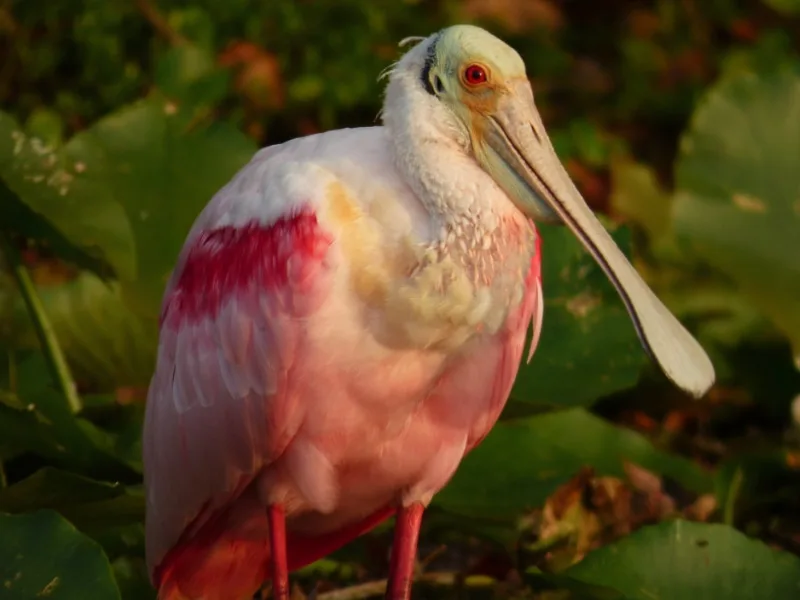
At first glance, the roseate spoonbill’s vibrant pink plumage might make it seem beautiful, but a closer look reveals one of the strangest beaks in the bird world. Its long, flat, spoon-shaped bill makes it look almost comically out of proportion, and its bald, pale-green head only adds to its oddness. With its gangly legs, hunched posture, and habit of sweeping its beak side to side in murky water, the spoonbill can appear both awkward and goofy. Despite its unusual look, this bird is a skilled feeder, able to detect prey even in muddy environments.
Why does it look this way?
The spoon-shaped beak is a highly specialized feeding tool, allowing the roseate spoonbill to sweep through shallow water and detect prey by touch. This gives it an advantage in murky wetlands where visibility is low. The bald head likely helps keep its feathers clean, as it often sticks its face into the mud while foraging. Its pink coloration comes from its diet of shrimp and other crustaceans, much like flamingos. While it might look awkward and mismatched, the roseate spoonbill is a perfectly adapted wetland hunter that thrives in its environment, if humans allow it to.
Long-wattled umbrellabird (Cephalopterus penduliger)
- Why ugly? Oversized, pompadour-like crest and an absurdly long, feathered throat wattle make it look exaggerated and awkward.
- Where found? Cloud forests of western Colombia and Ecuador.
- What it eats? Mostly fruit, but also insects and small vertebrates.
- Status? Vulnerable, with deforestation rapidly shrinking its habitat.

The long-wattled umbrellabird looks like something out of a surreal cartoon. With its huge, feathery crest covering most of its face and a ridiculously long, inflatable throat wattle dangling down to its chest, it is one of the most bizarre-looking birds in the world. Males use their oversized throat pouch in elaborate courtship displays, puffing it up to amplify their deep, booming calls. Watching one in action can be both fascinating and slightly unsettling, as its inflated wattle bobs awkwardly with each movement.
Why does it look this way?
The exaggerated crest and long wattle are sexual selection traits, meaning they evolved because females prefer males with these extreme features. The throat wattle acts as a resonator, amplifying the umbrellabird’s low, booming call, which can travel through dense forest. While its goofy, almost comical appearance might seem impractical, these features help males attract mates and establish dominance. Unfortunately, this strange and unique species is rapidly losing habitat due to deforestation, putting its future at risk.
Kakapo (Strigops habroptilus)
- Why ugly? Chubby, flightless body, mossy-green feathers, and a round, owl-like face give it a comically awkward look.
- Where found? Forested islands of New Zealand.
- What it eats? Leaves, seeds, fruits, and nectar.
- Status? Critically Endangered, with fewer than 300 individuals remaining.

The kakapo is a one-of-a-kind parrot that defies almost every expectation of what a parrot should be. It is heavy, slow-moving, and completely flightless, relying on its strong legs to waddle and climb trees rather than fly. With its plump, round body, mossy green feathers, and small, dish-shaped face, it has an almost goofy, stuffed animal-like appearance. Its unusual habits make it even stranger – kakapos are nocturnal, emit a musky odor, and freeze in place when threatened, making them incredibly vulnerable to predators.
Why does it look this way?
The kakapo evolved in a predator-free environment, meaning it never needed to develop speed, flight, or strong defenses. Instead, it relies on camouflage, with its green, mottled feathers helping it blend into the forest floor. Its large, owl-like face improves low-light vision, which is crucial for its nocturnal lifestyle. The chubby, slow-moving body is a result of its energy-efficient lifestyle, as it spends most of its time foraging on the ground. While its awkward, clumsy look makes it one of the goofiest birds on Earth, the kakapo is also one of the rarest, surviving only through intensive conservation efforts.
Muscovy duck (Cairina moschata)
- Why ugly? Warty red facial skin, bulky body, and often messy feathers give it a scruffy, unpolished look.
- Where found? Native to Central and South America; domesticated worldwide.
- What it eats? Plants, seeds, insects, small fish, and even carrion.
- Status? Least Concern, with stable wild populations and widespread domestication.
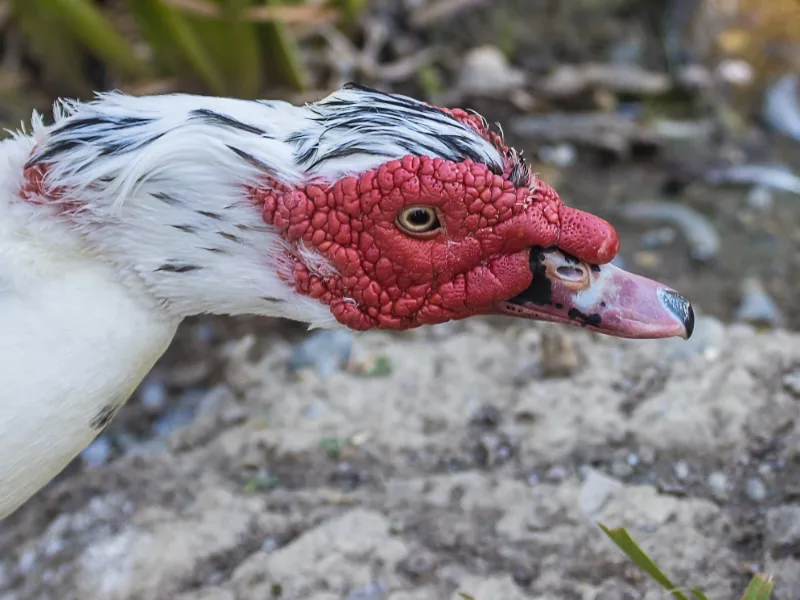
The Muscovy duck is one of the most instantly recognizable and bizarre-looking ducks, thanks to its bumpy, red facial skin, which makes it look wrinkled and swollen. Unlike other ducks, it has a bulkier, more goose-like body and often appears somewhat unkempt, with patchy, oily feathers and an awkward posture. While domestic Muscovies come in various colors, wild ones are usually black with white wing patches, adding to their distinctive, rugged appearance. Instead of the typical quacking sound of most ducks, Muscovies communicate with hisses, grunts, and low-pitched whispers, which only adds to their strange personality.
Why does it look this way?
The warty red skin on the face is called caruncles, and it plays a role in mate selection and social signaling – larger caruncles often indicate stronger, more dominant males. This extra skin also helps with thermoregulation, releasing heat in warm climates. The stocky body and powerful legs make Muscovies strong fliers in the wild, unlike their domestic counterparts, which have been bred for size and often struggle to take off. Though its rough, scruffy look makes it one of the goofiest and strangest ducks, the Muscovy is an adaptable survivor, thriving in both urban and wild environments.
Potoo (Nyctibius spp.)
- Why ugly? Huge, bulging eyes, wide frog-like mouth, and an eerie, unmoving posture make it look ghostly and unsettling.
- Where found? Forested regions of Central and South America.
- What it eats? Flying insects, caught mid-air with its wide mouth.
- Status? Mostly Least Concern, but some species are threatened due to habitat loss.

If there were ever a bird that looked like it belonged in a horror movie, it would be the potoo. With enormous, glowing eyes, a wide, gaping mouth, and a habit of freezing in place like a possessed tree branch, this nocturnal bird is both creepy and comical. During the day, it perches motionless, mimicking a broken stump, making it nearly impossible to spot. But at night, it becomes an expert insect hunter, using its massive mouth to snatch moths and beetles in mid-air. Adding to its eerie reputation, some species produce haunting, wailing calls that sound like distant cries in the dark.
Why does it look this way?
The potoo’s huge, lidless eyes allow it to see in extreme darkness, helping it detect insects at night. Its bizarrely wide mouth functions as a built-in net, letting the bird scoop up prey effortlessly while flying. Its feather pattern is perfectly designed to blend with tree bark, and when threatened, it freezes completely, stretching its body to look like a broken branch. This camouflage strategy is so effective that many predators never even notice the bird is there. Though its weird, ghost-like appearance might seem unsettling, the potoo is a brilliantly adapted nocturnal predator that thrives in the shadows.
Capuchinbird (Perissocephalus tricolor)
- Why ugly? Bald, vulture-like head, fluffy orange-brown body, and an awkward hunched posture give it an unsettling, mismatched look.
- Where found? Lowland rainforests of northern South America, including Venezuela, Colombia, Brazil, and Guyana.
- What it eats? Mostly fruit, but also insects and small vertebrates.
- Status? Least Concern, though deforestation threatens some local populations.
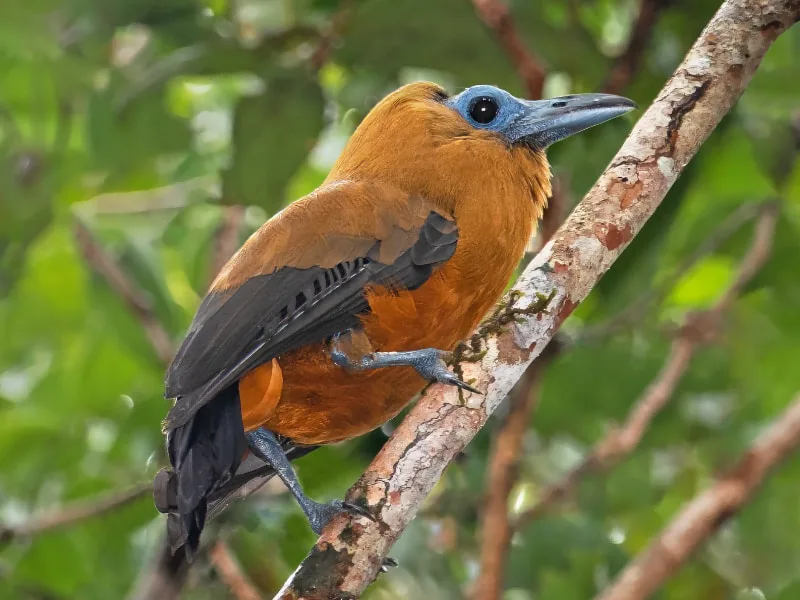
The capuchinbird is a parrot relative that looks more like a vulture. With its bald, pale head, thick beak, and fluffy, orange-brown plumage, it has an almost unfinished appearance, as if evolution forgot to complete the job. Its hunched posture and slow, deliberate movements only add to its oddity, making it look awkward and eerie as it perches in the rainforest. But what truly sets this bird apart is its low, cow-like call, which sounds more like a moaning farm animal than a bird.
Why does it look this way?
The bald head is likely an adaptation to avoid feather contamination while feeding on sticky, fleshy fruits. Many fruit-eating birds have sleek, oily feathers to help with hygiene, but the capuchinbird’s bare skin reduces mess while feeding. Its deep, resonant call is an essential part of its mating ritual, as males gather in lekking groups to produce loud, eerie moans to attract females. While its odd, vulture-like face and bizarre vocalizations might seem out of place, the capuchinbird is a highly specialized rainforest frugivore, helping to spread seeds and maintain the ecosystem.
California condor (Gymnogyps californianus)
- Why ugly? Bald, wrinkled pinkish-orange head, oversized hooked beak, and a hunched, vulture-like posture.
- Where found? Rocky cliffs and canyons of western North America, mainly in California, Arizona, Utah, and Baja California.
- What it eats? Scavenger – feeds exclusively on carrion, including large mammals.
- Status? Critically Endangered, with fewer than 400 individuals in the wild.

The California condor is North America’s largest flying bird, with a wingspan of up to 3 meters (10 feet). While it soars majestically over rugged landscapes, up close, its bald, wrinkled head, piercing eyes, and heavy beak make it one of the most unsettling-looking birds in the world. Its long, finger-like feathers, hunched stance, and slow, deliberate movements give it a ghostly, almost prehistoric presence. Adding to its creepy aura, condors have a habit of staring intensely at people, sometimes for long periods, which has led to their association with death and omens in various Native American myths.
Why does it look this way?
The bald head is a crucial adaptation for its scavenging lifestyle, preventing bacteria from sticking to its feathers while feeding on decomposing carcasses. Its massive, hooked beak is powerful enough to tear through thick hides, allowing it to feed on large mammals like deer, cattle, and even marine mammals. The wrinkled skin on its head can change color, possibly as a form of communication or emotional signaling. While its scary, vulture-like appearance might be off-putting, the California condor plays a vital ecological role, preventing disease by consuming decaying remains. Thanks to intensive conservation efforts, this species has been slowly recovering from the brink of extinction.
Greater sage-grouse (Centrocercus urophasianus)
- Why ugly? Inflatable yellow air sacs, spiky tail feathers, and an awkward, puffed-up mating display make it look goofy and over-the-top.
- Where found? Sagebrush habitats of western North America, including the U.S. and Canada.
- What it eats? Mostly sagebrush, along with insects and other plants.
- Status? Near Threatened, with habitat loss due to agriculture and energy development.

The greater sage-grouse is one of the strangest-looking birds during its elaborate mating display. Males inflate two massive, yellow air sacs on their chests, producing a comical, popping sound while strutting and fanning their spiky, pointed tail feathers. The result is a ridiculously exaggerated display, with the bird looking like a mix between a balloon animal and a feathered pin cushion. While females appear more modest, the males’ absurd courtship dance makes them one of the goofiest, most awkward birds in the wild.
Why does it look this way?
The sage-grouse’s oversized air sacs evolved as part of a lekking mating system, where males gather in open spaces and compete for female attention. The popping, whooshing sounds they make help attract mates, with females choosing the most impressive performers. Their spiky tail feathers and exaggerated chest display serve as visual signals of strength and health. While their odd, clownish appearance is only temporary during the breeding season, it plays a crucial role in ensuring successful reproduction. Unfortunately, the sagebrush habitat that these birds depend on is rapidly shrinking, putting the future of this strange yet fascinating species at risk.
Sri Lanka frogmouth (Batrachostomus moniliger)
- Why ugly? Wide, frog-like mouth, scruffy feathers, and a perpetually surprised expression give it a comical, odd appearance.
- Where found? Rainforests of Sri Lanka and the Western Ghats of India.
- What it eats? Insects, especially moths and beetles.
- Status? Least Concern, but local populations are threatened by deforestation.

The Sri Lanka frogmouth is a small, nocturnal bird with an oversized, frog-like mouth, scruffy plumage, and a habit of sitting with its head tilted slightly upward, giving it a perpetually surprised look. Its body is covered in shaggy, disorganized feathers, making it look as if it just got out of bed. During the day, this bird remains almost perfectly still, relying on its camouflage to blend into its surroundings. Despite its goofy appearance, the Sri Lanka frogmouth is a master of disguise, often going completely unnoticed even when perched in plain sight.
Why does it look this way?
The wide mouth of the frogmouth is a highly effective tool for catching flying insects at night. It can open its beak very wide, allowing it to snatch prey mid-air like a net. Its scruffy, irregular plumage serves as camouflage, helping the bird blend into the forest undergrowth or tree branches during the day. Its large, round eyes are adapted for night vision, allowing it to spot prey in low light. While its odd, unkempt appearance might make it look comical, the Sri Lanka frogmouth is a highly specialized nocturnal predator, perfectly adapted to life in the dense rainforest.
Mossy-nest swiftlet (Aerodramus salangana)
- Why ugly? Scruffy, moldy-looking feathers and a habit of nesting in moss-covered caves give it a ragged, unkempt appearance.
- Where found? Southeast Asia, including Indonesia, Malaysia, and the Philippines.
- What it eats? Flying insects, caught mid-air.
- Status? Least Concern, though habitat disturbance threatens some populations.
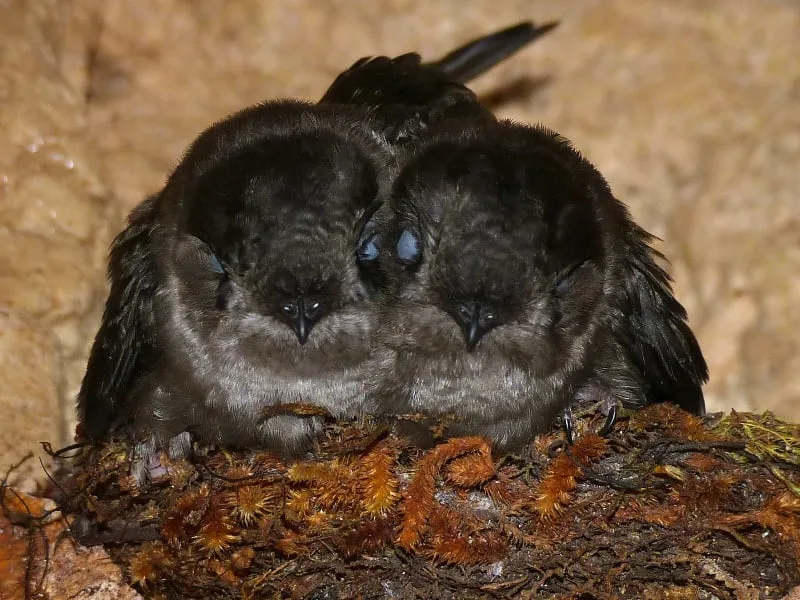
The mossy-nest swiftlet is small and unassuming, but its scruffy, dirty-looking feathers give it a neglected, unkempt appearance. Unlike other sleek and streamlined swifts, this species looks as if it has been rolled in moss and dust. Making it even stranger, its nostrils are positioned in a way that sometimes creates the illusion of an extra pair of tiny eyes, especially in dim light. This eerie effect, combined with its habit of huddling in nests and its preference for dark, humid caves, gives it a slightly otherworldly, unsettling look.
Why does it look this way?
The ragged, mossy-looking feathers help the swiftlet blend into cave walls, providing natural camouflage from predators. Unlike its relatives that build smooth, edible nests (like those used in bird’s nest soup), the mossy-nest swiftlet mixes plant materials into its saliva-based nests, making them more durable but also rougher in appearance. Its small size and rapid flight allow it to hunt insects on the wing, but when at rest, its dusty, uneven plumage makes it look unkempt and slightly eerie. While it might not be the most conventionally attractive swift, the mossy-nest swiftlet is an efficient aerial hunter, perfectly adapted to life in the shadows of humid caves.
Bearded vulture (Gypaetus barbatus)
- Why ugly? Piercing red eyes, scruffy “beard,” and a habit of staining itself with blood give it a menacing, almost demonic look.
- Where found? Mountainous regions of Europe, Africa, and Asia.
- What it eats? Primarily bones, which it crushes and swallows whole.
- Status? Near Threatened, with population declines due to poisoning and habitat destruction.
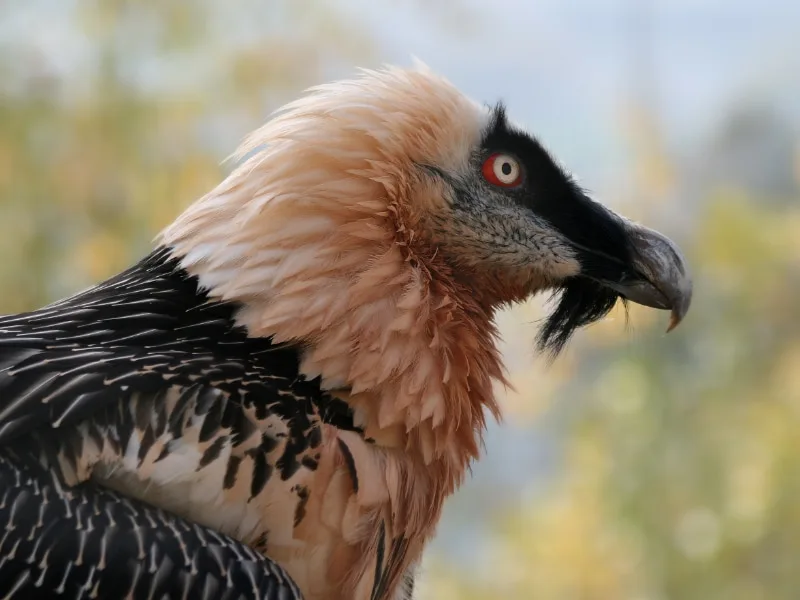
The bearded vulture is one of the most intimidating-looking birds in the world. With piercing red eyes, a ragged, dark “beard” of feathers, and a habit of deliberately staining its own feathers with blood, it looks like something out of a gothic horror story. Unlike other vultures, which feed on rotting flesh, the bearded vulture prefers bones – a diet that has earned it the nickname “bone breaker”. It carries large bones high into the air and drops them onto rocks to shatter them into bite-sized pieces, which it then swallows whole.
Why does it look this way?
The bearded vulture’s fearsome appearance is largely a result of its unique diet and behavior. Its powerful stomach acid allows it to digest bones completely, giving it an advantage over other scavengers. The blood-stained feathers are not an accident – these birds deliberately rub themselves with iron-rich soil and animal blood, possibly as a status signal to intimidate rivals or attract mates. Its hooked beak and piercing red eyes add to its terrifying image, but in reality, the bearded vulture is a skilled and highly specialized scavenger that plays a crucial role in mountain ecosystems.
New Zealand kaka (Nestor meridionalis)
- Why ugly? Scruffy, patchy feathers, a hooked beak, and a mischievous expression give it a rough, ragged look.
- Where found? Forests of New Zealand, including the North and South Islands.
- What it eats? Nectar, fruits, seeds, invertebrates, and tree sap.
- Status? Vulnerable, due to habitat destruction and predation by invasive species.

The New Zealand kaka is a large, noisy parrot with shaggy, unkempt feathers, often looking like it’s just been caught in a rainstorm. Its hooked beak and constantly curious expression give it a slightly goofy but mischievous appearance. Unlike its close relative, the kea, which thrives in alpine environments, the kaka is a forest-dwelling trickster, known for its loud, croaky calls and playful, sometimes destructive behavior. In Maori culture, kakas were once considered messengers of the gods, though their raucous nature made them both respected and annoying to early settlers.
Why does it look this way?
The kaka’s scruffy, ragged feathers help it blend into New Zealand’s dense forests, while its strong, curved beak is adapted for tearing bark to access tree sap and insects. Its bare, scaly facial skin develops with age, possibly helping with heat regulation or reflecting its dominance. The kaka is an opportunistic feeder, using its dexterous feet and beak to manipulate food, sometimes even stealing nectar from tui birds. While its disheveled, rough look makes it appear a bit unkempt and strange, the kaka is an intelligent, highly social parrot that plays a vital role in seed dispersal and forest health.
Philippine eagle (Pithecophaga jefferyi)
- Why ugly? Large, piercing eyes, a shaggy, disheveled crest, and an intense glare give it a fierce, almost unsettling look.
- Where found? Rainforests of the Philippines.
- What it eats? Mainly monkeys, flying lemurs, and other small mammals, along with birds and reptiles.
- Status? Critically Endangered, with fewer than 400 individuals due to deforestation and hunting.

The Philippine eagle is both majestic and intimidating, often described as having a piercing, almost human-like stare that makes it look eerily intense. Its shaggy, feathered crest gives it an unkempt, wild appearance – almost as if it just woke up from a rough night. Despite its regal size (it’s one of the largest and most powerful eagles in the world), its intense, fixed gaze and heavy brow ridges make it look perpetually angry or unsettlingly focused. Unlike most eagles, which hunt birds or fish, this apex predator is known for preying on monkeys, adding to its fierce reputation.
Why does it look this way?
The Philippine eagle’s shaggy crest helps intimidate rivals and attract mates, while its massive hooked beak and powerful talons are built for tearing through prey. Its forward-facing eyes give it precise binocular vision, but its nictitating membrane (a translucent third eyelid) adds an even creepier effect, making its stare appear ghostly and otherworldly. Though it looks wild and fierce, this highly specialized rainforest hunter plays a crucial role in its fragile ecosystem. Sadly, deforestation and poaching have pushed it to the brink of extinction, making it one of the rarest eagles in the world.
Southern screamer (Chauna torquata)
- Why ugly? Scruffy gray feathers, long pink legs, a small head, and a black “collar” give it a mismatched, almost cartoonish appearance.
- Where found? Wetlands and grasslands of South America, particularly Argentina, Bolivia, Brazil, and Paraguay.
- What it eats? Mostly plants, but also small invertebrates.
- Status? Least Concern, with stable populations, though wetland destruction poses a threat in some regions.
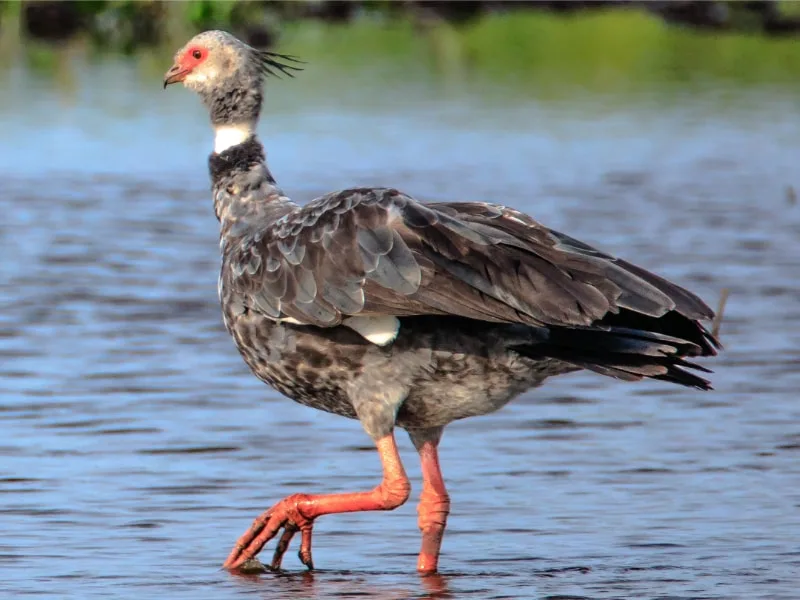
The southern screamer is one of the strangest-looking birds in South America. With its oversized body, long, thin legs, tiny head, and ragged plumage, it looks awkward and mismatched, as if it were pieced together from different bird species. Adding to its odd appearance is its black feather “collar” around its neck, making it look almost like it’s wearing a medieval ruff. But what really sets it apart is its unbelievably loud, haunting scream, which can carry for miles and sounds more like a distressed mammal than a bird. Despite its goofy, almost clumsy looks, this bird is surprisingly aggressive and capable of defending itself with powerful wing spurs.
Why does it look this way?
The long legs and bulky body help the southern screamer navigate wetlands and grasslands, allowing it to wade through marshes with ease. Its scruffy, loose feathers help insulate it from cold nights in open landscapes. The sharp spurs on its wings, which it uses in fights with other birds, are a leftover from ancient bird ancestors. While its odd proportions, loud calls, and strange feather patterns make it look both comical and slightly creepy, the southern screamer is a tough, territorial bird that plays an important role in maintaining wetland ecosystems.
Southern bald ibis (Geronticus calvus)
- Why ugly? Bare, wrinkled red head, hunched posture, and dark, iridescent feathers give it a vulture-like, eerie look.
- Where found? Grasslands and rocky outcrops of South Africa, Lesotho, and Eswatini.
- What it eats? Insects, small vertebrates, and plant matter.
- Status? Near Threatened, with habitat destruction and human disturbance reducing populations.

The southern bald ibis looks more like a vulture than an ibis, with its bald, wrinkled red head and hunched stance. Unlike its more elegant ibis relatives, this species lacks the sleek, curved-beak beauty and instead looks like a scruffy, prehistoric relic. Its dark, iridescent feathers shimmer in the sunlight, giving it an odd, oil-slick appearance. The bird often moves in small groups, foraging across dry grasslands in a way that makes them seem like shadowy scavengers on the landscape.
Why does it look this way?
Like other bald-headed birds, the lack of feathers on its head is likely an adaptation to keep clean while feeding on messy prey, such as insects and carrion. The dark plumage absorbs heat, helping the bird stay warm in cooler high-altitude habitats. Despite its slightly menacing and scruffy look, the Southern Bald Ibis is a highly social bird, forming close bonds within its flocks. However, its distinctive, eerie appearance has not always worked in its favor – local folklore in some regions once associated these birds with bad omens and misfortune.
Northern bald ibis (Geronticus eremita)
- Why ugly? Scraggly black mane, bald wrinkled head, and piercing eyes give it a haunting, almost otherworldly look.
- Where found? Rocky cliffs and semi-arid regions of North Africa, the Middle East, and southern Europe.
- What it eats? Insects, lizards, and small mammals.
- Status? Endangered, with only a few wild populations surviving due to habitat loss and hunting.

If there’s one bird that looks straight out of a medieval bestiary, it’s the northern bald ibis. With its bare, wrinkled red head, long, curved beak, and scruffy black crest, this bird looks more like a scavenger from a dark fairytale than a wetland bird. Unlike other ibises that thrive in marshes, this species prefers rocky, arid landscapes, adding to its unusual mystique. Historically, the northern bald ibis was revered in ancient Egypt, where it was considered sacred and a symbol of fertility – a stark contrast to its more recent decline, where it has become one of the rarest ibis species in the world.
Why does it look this way?
The bald head and intense, piercing gaze make this ibis look almost vulture-like, but these traits help it regulate heat and keep clean while foraging. The scruffy mane of black feathers along the back of its neck may serve a display function, making individuals appear larger or more imposing. While its strange, haunting look might make it seem like a creature of myths, this species is actually an important part of its ecosystem, controlling insect populations and aerating the soil with its foraging. Conservation efforts in Europe and the Middle East have attempted to bring this bird back from the brink, but it remains one of the rarest and most unusual-looking ibises alive today.
Jabiru (Jabiru mycteria)
- Why ugly? Thick, black, wrinkled neck, a massive, oversized beak, and a bald head make it look ancient and awkward.
- Where found? Wetlands and floodplains of Central and South America, from Mexico to Argentina.
- What it eats? Fish, amphibians, reptiles, and carrion.
- Status? Least Concern, though habitat destruction affects local populations.
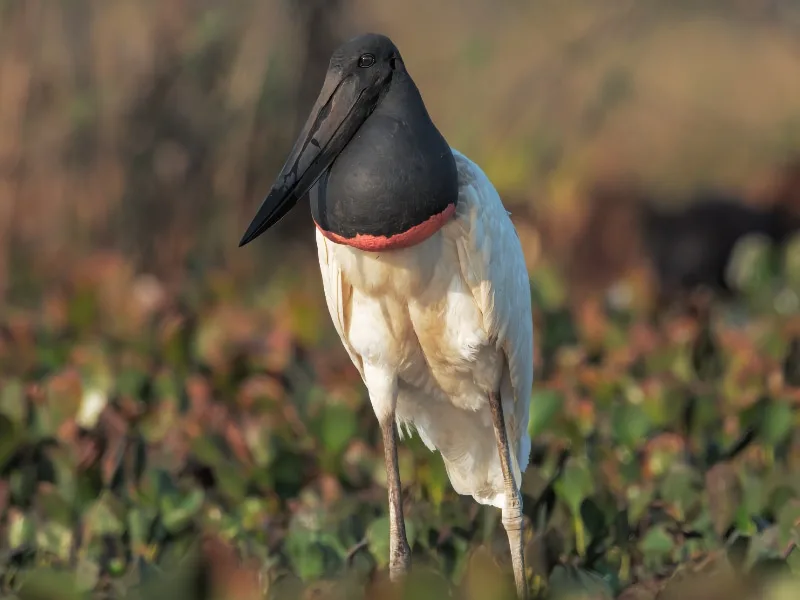
The jabiru is the largest stork in the Americas, towering at up to 1.5 meters (5 feet) tall with a wingspan of over 2.8 meters (9 feet). While it looks majestic in flight, up close, it has an odd, prehistoric appearance, with a bald, wrinkled black neck and an absurdly large beak that seems too heavy for its face. Adding to its strange look is the inflatable red pouch at the base of its neck, which swells when the bird becomes excited or agitated. Often seen wading through shallow waters with a slow, deliberate gait, the Jabiru can appear both graceful and slightly unsettling at the same time.
Why does it look this way?
The thick, wrinkled neck and bald head are adaptations for keeping clean while feeding in murky waters, preventing feathers from getting clogged with mud or fish slime. The enormous beak, one of the largest of any stork species, is used for grabbing slippery prey like fish and frogs with ease. The inflatable red throat sac likely plays a role in communication and courtship displays, as males often swell it when interacting with rivals or potential mates. While its awkward, ancient-looking face might make it seem odd and even scary, the jabiru is an expert hunter and a vital part of wetland ecosystems, keeping fish and amphibian populations in check.
Vulturine guineafowl (Acryllium vulturinum)
- Why ugly? Bald, vulture-like head, piercing red eyes, and long, striped neck feathers give it a creepy, otherworldly look.
- Where found? Dry savannas and scrublands of East Africa, including Kenya, Ethiopia, and Tanzania.
- What it eats? Seeds, insects, and small invertebrates.
- Status? Least Concern, with stable populations.

The vulturine guineafowl looks like something between a vulture and a prehistoric dinosaur bird. With a bald, bluish-gray head, intense red eyes, and a long, narrow neck covered in streaked blue-and-white feathers, it has an unsettling and almost alien-like appearance. Unlike the rounder, more familiar guineafowl species, the vulturine guineafowl has a sleeker, elongated body that makes it look both elegant and eerie. Its bare, bony face and sharp gaze add to its vulture-like resemblance, but despite its looks, this bird is not a scavenger – it prefers pecking at seeds and insects while roaming in large, noisy flocks.
Why does it look this way?
The bald head and long neck help the vulturine guineafowl stay cool in hot, arid environments, reducing heat absorption compared to feathered-headed birds. Its elongated shape and smooth, curved feathers make it more agile when darting through dry grasslands to escape predators. The bright blue and black plumage, while striking, may serve as social signals within flocks, helping individuals recognize each other. Though its vulture-like head and eerie red stare might make it seem intimidating, this bird is a highly social species, often gathering in large groups to forage and roost together.
Wild turkey (Meleagris gallopavo)
- Why ugly? Warty, wrinkled head, dangling snood, and a mix of scruffy feathers give it a bizarre, almost prehistoric look.
- Where found? Forests, grasslands, and open woodlands across North America, from Canada to Mexico.
- What it eats? Seeds, insects, berries, and small reptiles.
- Status? Least Concern, with healthy populations despite past overhunting.

The wild turkey is both comical and unsettling, with its bare, wrinkled pinkish-red head, fleshy throat wattles, and a long, dangling snood that flops over its beak. Males are even stranger-looking when displaying, as they puff up their feathers, fan their tails, and turn their heads bright blue and red, making them look like a mix between a dinosaur and a feathered balloon. Unlike their domestic turkey relatives, which have been bred for bulk, wild turkeys are sleek, fast, and surprisingly agile, capable of running at 40 km/h (25 mph) – a speed that places them among the world’s fastest-running birds.
Why does it look this way?
The bald, bumpy head and snood serve several purposes – they help with heat regulation, prevent feather contamination while feeding, and play a role in mate attraction. The bright red, blue, and even white color changes in males signal dominance and excitement, as the skin flushes with blood. The large, iridescent body feathers, while appearing scruffy up close, provide excellent camouflage in the wild, helping turkeys blend into forests and grasslands. Though often mocked for their awkward looks, wild turkeys are highly intelligent, strong fighters, and have even been known to chase off predators like coyotes.
Saddle-billed stork (Ephippiorhynchus senegalensis)
- Why ugly? Oversized, multicolored beak, long thin legs, and an awkwardly elongated neck make it look oddly proportioned.
- Where found? Wetlands and riverbanks across sub-Saharan Africa.
- What it eats? Fish, amphibians, small reptiles, and insects.
- Status? Least Concern, though wetland destruction threatens some populations.
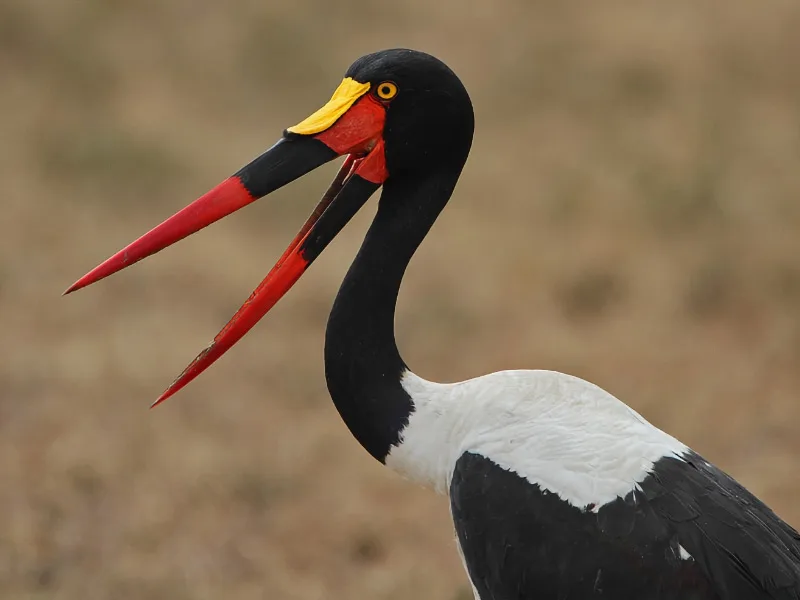
The saddle-billed stork looks like a bird that couldn’t decide what color it wanted to be. With its massive red-and-black bill, a bright yellow “saddle” on top, long white-and-black legs, and glossy black wings, it seems both elegant and awkward at the same time. Its tall, thin frame, reaching up to 1.5 meters (5 feet) in height, gives it a slightly unbalanced appearance, especially when it moves with slow, deliberate steps through shallow water. Unlike many storks, the saddle-billed stork is almost completely silent, which somehow makes its intense stare and sharp beak even more unsettling.
Why does it look this way?
The massive, brightly colored beak is an adaptation for catching and handling slippery prey in the water. The saddle-shaped yellow marking on its bill is a unique feature, likely used for species recognition and communication. Its long, spindly legs allow it to wade through wetlands without making noise, while its sharp bill can strike fish and amphibians with impressive speed. Despite its strange, multicolored, slightly goofy appearance, the saddle-billed stork is an efficient, silent hunter, playing a crucial role in wetland ecosystems by keeping fish and amphibian populations in check.
Southern ground hornbill (Bucorvus leadbeateri)
- Why ugly? Wrinkled, bright red throat skin, massive beak, and intense stare give it a prehistoric, unsettling look.
- Where found? Open savannas and grasslands of sub-Saharan Africa.
- What it eats? Insects, small mammals, reptiles, and carrion.
- Status? Vulnerable, with habitat destruction and hunting reducing populations.

The southern ground hornbill is one of the strangest hornbills, looking more like a land-dwelling vulture than a typical hornbill. Instead of living in trees, it walks through the grasslands like a dinosaur, using its enormous, heavy beak to catch prey. Unlike most hornbills, which have brightly colored beaks and casques, this species has a mostly black beak, but with intense, wrinkled red skin around the eyes and throat. When calling, its inflatable throat sac expands like a balloon, producing deep, booming sounds that can be heard over great distances.
Why does it look this way?
The bare, wrinkled red skin helps regulate body temperature in Africa’s hot climate, while also playing a role in social signaling and mating displays. The massive, hooked beak is not just for show – it allows the bird to catch and kill small animals, making it one of the few hornbills that actively hunt live prey. Its slow, deliberate movements and intense stare give it a slightly eerie presence, making it look both goofy and menacing at the same time. Though its strange, prehistoric appearance might make it seem out of place, the southern ground hornbill is a highly intelligent, long-lived species, playing a vital role in controlling insect and rodent populations in the African savanna.
Why do these birds look so strange?
At first glance, the birds on this list may seem ugly, creepy, or even monstrous, but every odd feature has been shaped by evolution for a reason. Bald heads, seen in vultures and storks, prevent bacteria from contaminating feathers after feeding on carrion. Oversized beaks, like those of hornbills and storks, allow for precise foraging, whether it’s scooping fish from water or cracking bones for marrow. Strange facial wattles and throat sacs, as seen in turkeys and condors, serve roles in thermoregulation, mate attraction, and dominance displays. Even the unblinking stare of the shoebill and the ghostly camouflage of the potoo are critical adaptations for hunting and survival.
In many cases, what we consider ugly or unsettling is simply a matter of function over form. Evolution does not care for aesthetics, it only rewards traits that help a species thrive in its environment. Some of these birds have been unchanged for millions of years, proof that their seemingly bizarre adaptations are not flaws but finely tuned survival mechanisms.
While some of these birds are thriving, others are in serious danger of disappearing forever. The Philippine eagle, California condor, helmeted hornbill, and kakapo are all critically endangered, facing habitat loss and human threats. Even species that seem widespread, like vultures, are declining rapidly due to poisoning and habitat destruction.
At Planet of Birds, we believe that every species matters, no matter how strange or scary it may appear. These birds are not just curiosities – they are essential parts of ecosystems, preventing disease, controlling prey populations, and maintaining balance in nature. Protecting them means protecting biodiversity itself.
Some of these species need immediate help. Conservation efforts, from habitat protection to captive breeding programs, are the only things standing between survival and extinction for many of them. Perhaps it’s time we stop judging these birds by their looks and start appreciating them for their true beauty – their resilience, uniqueness, and crucial roles in the wild.
Further reading
